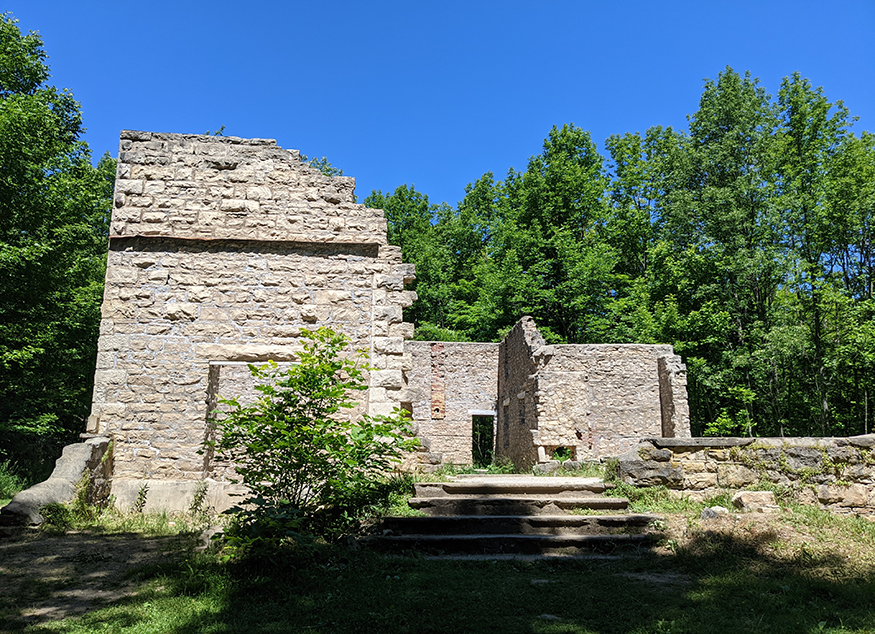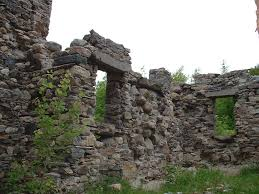160 Unusual Things to See in Ontario ~ 3 Castle Ruins
Ruins: The Corran, the Hermitage, Osler Castle
The Corran Ruins
Spirit Rock Conservation Area
92 HIGHWAY 6, WIARTON ON,
Spirit Rock & McNeil Estate is a popular site in Bruce County where you can take in an impressive view of Colpoy's Bay and hike over 5 km of trails. A must-see feature on this property is the spiral staircase that winds down the escarpment to the shoreline. The Corran ruins of the McNeill Estate offer a glimpse into the past and are a highlight for history-lovers!

The ruins of the McNeill Estate provide a glimpse into some of the history of Bruce County and its settlers.
In 1881, this site became home for Alexander McNeill who developed the land into beautiful garden, manicured lawns and productive orchards. The heart of the estate was the Corran, a 17-room mansion lavished with carvings, ancient weapons, tapestries and book-lined walls.
The Gaelic meaning for Corran is ‘point of land running into the sea’. McNeill’s mansion was modeled and named after his childhood home in Northern Ireland.

Alexander McNeill was born in Northern Ireland and served as the Federal Member of parliament for the North Bruce Riding, 1881-1901. He was a supporter of Britain and its empire and one of the ‘Noble 13’ who opposed Sir John A. Macdonald on a number of issues.
McNeill was a quiet man, fond of reading and a lover of flowers. He lived on the estate with his wife Hester and their son Malcolm. Hester died quite young, before the estate was completely finished. Unfortunately, after McNeill died, Malcolm was more interested in parties than managing the estate, and the family fortune dwindled away.
Following Malcolm’s death, the housekeeper, who had been willed the estate, sold it in 1960 to a Toronto resident. Without fulltime occupancy at the mansion, the site frequently experienced vandalism. The property was sold in 1976 to the Conservation Authority. Shortly after, a fire destroyed the mansion, leaving only a stone shell, which is still visible today.
The Hermitage Ruins
The Hermitage was a large residence situated in Ancaster, Hamilton, Ontario, Canada, which now exists as ruins and is part of The Hermitage and Gatehouse Museum maintained by the Hamilton Conservation Authority. The location is a popular destination for hikers and people interested in the paranormal.
The Hermitage was originally built in 1830 by the Reverend George Sheed. The property is about two miles west of Ancaster, in the Dundas Valley.
Otto Ives (1801–1835) was the third land owner. He was an English officer who had fought in the Greek War of Independence against the Ottoman Empire. He met Magdalene Diamanti, a daughter of the Governor of an Aegean island. They married in Corfu in 1824, and had arrived in Ancaster by 1833. They brought her sister or niece with them to act as a companion for Mrs Ives. It was here that Otto Ives purchased the Hermitage from the heirs of George Sheed. Ives had hired a coachman by the name of William Black. Although it is said that Black was also a tutor in the English language, evidence exists that this post was filled by Mary Rosebeury (later Mrs Peter Filman of Hamilton).
The ladies of the household spoke only Greek, and it is said that Black fell in love with the sister or niece. Black asked Otto Ives for his niece's hand in marriage, but Ives was very upset by the thought, and rejected the proposal. The next morning, Ives and his wife were due to go out for the day, but the coachman was not at the front door with the carriage as planned. Ives went out to the barn to see why the coachman had not appeared, and discovered Black's body hanging from the rafters in the barn near the first Hermitage.
Although this story has become legend in Ancaster, and although Otto Ives owned the Hermitage in the 1830s, there is little other information from the time to substantiate the legend of the coachman and the niece's love affair. There is also a note appended to deeds of sale, mentioning that a family friend had hanged himself from a tree in the bush, because of love for the niece.
In 1853, the Hermitage was purchased by George Gordon Browne Leith (1812–1887) and his wife Eleanor Ferrier (1814–1900). Over the next several years, a large stone house, attendant outbuildings, a farmhouse, barns, and entrance lodge were constructed.
After Mrs Leith's death, the property was purchased by her youngest daughter, Eleanor Alma Dick Lauder (1854–1942). She lived here until the house was destroyed by fire in 1934, and afterwards, in a small house constructed inside the ruins.
The Osler Castle
Osler Castle (Kionontio) is located near the Town of Blue Mountains, Ontario. Osler Castle was built on Blue Mountain in 1893 by Toronto lawyer Britton Bath Osler (the Crown Attorney at the trial of Louis Riel and founder of the law firm Osler, Hoskin and Harcourt). Osler built this 15-room all-stone manor for his ailing wife Caroline in hope that the ‘fresh air’ would improve her health. Caroline named this summer house ‘Kionontio,’ a Petun Indian word for 'top of the hill'.
Unfortunately, after enjoying only a few summers at Osler Castle, Caroline succumbed to her illness and died in 1896. Osler remarried and continued to spend time at the Castle, but when he died in 1901, the empty manor was left to deteriorate. Vegetation, weather, vandals and evidence of many a bush party took their toll, reducing Osler Castle to ruins by the 1950s.
Today the property is owned by Castle Glen Development Corporation and is slated for residential development. Perhaps the ruins of the historically significant structure will be saved from demolition.
Please note that this is private property. Do not leave the trail or enter the ruins.
The Corran Ruins
Spirit Rock Conservation Area
92 HIGHWAY 6, WIARTON ON,
Spirit Rock & McNeil Estate is a popular site in Bruce County where you can take in an impressive view of Colpoy's Bay and hike over 5 km of trails. A must-see feature on this property is the spiral staircase that winds down the escarpment to the shoreline. The Corran ruins of the McNeill Estate offer a glimpse into the past and are a highlight for history-lovers!

The ruins of the McNeill Estate provide a glimpse into some of the history of Bruce County and its settlers.
In 1881, this site became home for Alexander McNeill who developed the land into beautiful garden, manicured lawns and productive orchards. The heart of the estate was the Corran, a 17-room mansion lavished with carvings, ancient weapons, tapestries and book-lined walls.
The Gaelic meaning for Corran is ‘point of land running into the sea’. McNeill’s mansion was modeled and named after his childhood home in Northern Ireland.

Alexander McNeill was born in Northern Ireland and served as the Federal Member of parliament for the North Bruce Riding, 1881-1901. He was a supporter of Britain and its empire and one of the ‘Noble 13’ who opposed Sir John A. Macdonald on a number of issues.
McNeill was a quiet man, fond of reading and a lover of flowers. He lived on the estate with his wife Hester and their son Malcolm. Hester died quite young, before the estate was completely finished. Unfortunately, after McNeill died, Malcolm was more interested in parties than managing the estate, and the family fortune dwindled away.
Following Malcolm’s death, the housekeeper, who had been willed the estate, sold it in 1960 to a Toronto resident. Without fulltime occupancy at the mansion, the site frequently experienced vandalism. The property was sold in 1976 to the Conservation Authority. Shortly after, a fire destroyed the mansion, leaving only a stone shell, which is still visible today.
The Hermitage Ruins
The Hermitage was a large residence situated in Ancaster, Hamilton, Ontario, Canada, which now exists as ruins and is part of The Hermitage and Gatehouse Museum maintained by the Hamilton Conservation Authority. The location is a popular destination for hikers and people interested in the paranormal.
The Hermitage was originally built in 1830 by the Reverend George Sheed. The property is about two miles west of Ancaster, in the Dundas Valley.
Otto Ives (1801–1835) was the third land owner. He was an English officer who had fought in the Greek War of Independence against the Ottoman Empire. He met Magdalene Diamanti, a daughter of the Governor of an Aegean island. They married in Corfu in 1824, and had arrived in Ancaster by 1833. They brought her sister or niece with them to act as a companion for Mrs Ives. It was here that Otto Ives purchased the Hermitage from the heirs of George Sheed. Ives had hired a coachman by the name of William Black. Although it is said that Black was also a tutor in the English language, evidence exists that this post was filled by Mary Rosebeury (later Mrs Peter Filman of Hamilton).
The ladies of the household spoke only Greek, and it is said that Black fell in love with the sister or niece. Black asked Otto Ives for his niece's hand in marriage, but Ives was very upset by the thought, and rejected the proposal. The next morning, Ives and his wife were due to go out for the day, but the coachman was not at the front door with the carriage as planned. Ives went out to the barn to see why the coachman had not appeared, and discovered Black's body hanging from the rafters in the barn near the first Hermitage.
Although this story has become legend in Ancaster, and although Otto Ives owned the Hermitage in the 1830s, there is little other information from the time to substantiate the legend of the coachman and the niece's love affair. There is also a note appended to deeds of sale, mentioning that a family friend had hanged himself from a tree in the bush, because of love for the niece.
In 1853, the Hermitage was purchased by George Gordon Browne Leith (1812–1887) and his wife Eleanor Ferrier (1814–1900). Over the next several years, a large stone house, attendant outbuildings, a farmhouse, barns, and entrance lodge were constructed.
After Mrs Leith's death, the property was purchased by her youngest daughter, Eleanor Alma Dick Lauder (1854–1942). She lived here until the house was destroyed by fire in 1934, and afterwards, in a small house constructed inside the ruins.
The Osler Castle
Osler Castle (Kionontio) is located near the Town of Blue Mountains, Ontario. Osler Castle was built on Blue Mountain in 1893 by Toronto lawyer Britton Bath Osler (the Crown Attorney at the trial of Louis Riel and founder of the law firm Osler, Hoskin and Harcourt). Osler built this 15-room all-stone manor for his ailing wife Caroline in hope that the ‘fresh air’ would improve her health. Caroline named this summer house ‘Kionontio,’ a Petun Indian word for 'top of the hill'.
Unfortunately, after enjoying only a few summers at Osler Castle, Caroline succumbed to her illness and died in 1896. Osler remarried and continued to spend time at the Castle, but when he died in 1901, the empty manor was left to deteriorate. Vegetation, weather, vandals and evidence of many a bush party took their toll, reducing Osler Castle to ruins by the 1950s.
Today the property is owned by Castle Glen Development Corporation and is slated for residential development. Perhaps the ruins of the historically significant structure will be saved from demolition.
Please note that this is private property. Do not leave the trail or enter the ruins.




Comments
Post a Comment